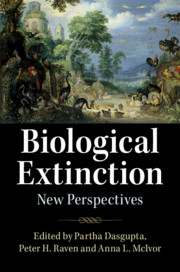Book contents
- Biological Extinction: New Perspectives
- Biological Extinction: New Perspectives
- Copyright page
- Dedication
- Contents
- Figures
- Tables
- Contributors
- Preface
- Acknowledgements
- Introduction
- Prologue
- 1 Extinction in Deep Time
- 2 Biodiversity and Global Change
- 3 The State of the World’s Biodiversity
- 4 Extinction Threats to Life in the Ocean and Opportunities for Their Amelioration
- 5 Out of the Soil
- 6 The Green Revolution and Crop Biodiversity
- 7 Population
- 8 Game Over?
- 9 Why We’re in the Sixth Great Extinction and What It Means to Humanity
- 10 The Consequences of Biodiversity Loss for Human Well-Being
- 11 Terra Incognita
- 12 How Do We Stem Biodiversity Loss?
- 13 Can Smart Villages Help to Stem Biodiversity Loss?
- 14 The New Design Condition
- Index
- Plate Section (PDF Only)
- References
13 - Can Smart Villages Help to Stem Biodiversity Loss?
Published online by Cambridge University Press: 19 August 2019
- Biological Extinction: New Perspectives
- Biological Extinction: New Perspectives
- Copyright page
- Dedication
- Contents
- Figures
- Tables
- Contributors
- Preface
- Acknowledgements
- Introduction
- Prologue
- 1 Extinction in Deep Time
- 2 Biodiversity and Global Change
- 3 The State of the World’s Biodiversity
- 4 Extinction Threats to Life in the Ocean and Opportunities for Their Amelioration
- 5 Out of the Soil
- 6 The Green Revolution and Crop Biodiversity
- 7 Population
- 8 Game Over?
- 9 Why We’re in the Sixth Great Extinction and What It Means to Humanity
- 10 The Consequences of Biodiversity Loss for Human Well-Being
- 11 Terra Incognita
- 12 How Do We Stem Biodiversity Loss?
- 13 Can Smart Villages Help to Stem Biodiversity Loss?
- 14 The New Design Condition
- Index
- Plate Section (PDF Only)
- References
Summary
Urban areas generate 80 per cent of global GDP (CBD, 1992; Ammann, 2016; Gressel, 2007) and no country has developed without urbanisation, according to Paul Collier (Dobbs et al., 2012; Collier, 2015). Just 2 per cent of the world’s population was urbanised in 1800; the figure passed 50 per cent by 2008, and on current trends it will reach 60 per cent by 2030. Virtually all this urban future growth will take place in developing countries, emulating Western Europe and North America, so that by 2025 it is estimated that 235 million households earning more than US$20,000 pa ppp will live in cities in the emerging economies, compared to 210 million in cities in the developed regions (Department for Business, Innovation and Skills, 2013). Cities are able to harness economies of scale and specialisation through the economies of agglomeration, but they consume 75 per cent of the world’s energy and are responsible for up to 70 per cent of global greenhouse gases (GHGs) (Satterthwaite, 2008).
- Type
- Chapter
- Information
- Biological ExtinctionNew Perspectives, pp. 358 - 404Publisher: Cambridge University PressPrint publication year: 2019
References
- 1
- Cited by

